May 5, 2021 | Climate Change, Poverty & Equity, Risk and resilience
By Julian Joseph, research assistant in the Water Security Research Group
Julian Joseph explains the concept of the triple dividend of disaster risk reduction investments based on the application of a novel economic model applied to a case study undertaken in Tanzania and Zambia.
What are the benefits of Disaster Risk Reduction (DRR) investments such as dams and the introduction of drought-resistant crops in agriculture for an economy? They are threefold and called the “triple dividend” of DRR investments. The first dividend comprises the direct effects of DRR investments, which limit damage to houses, infrastructure, and other physical assets and prevent death and injury. The second dividend unlocks the economic potential of an economy because risk reduction drives people and businesses to invest more, as they expect less of what they invest in to be destroyed by disasters, while the third dividend is comprised of development co-benefits through other uses the investments provide.
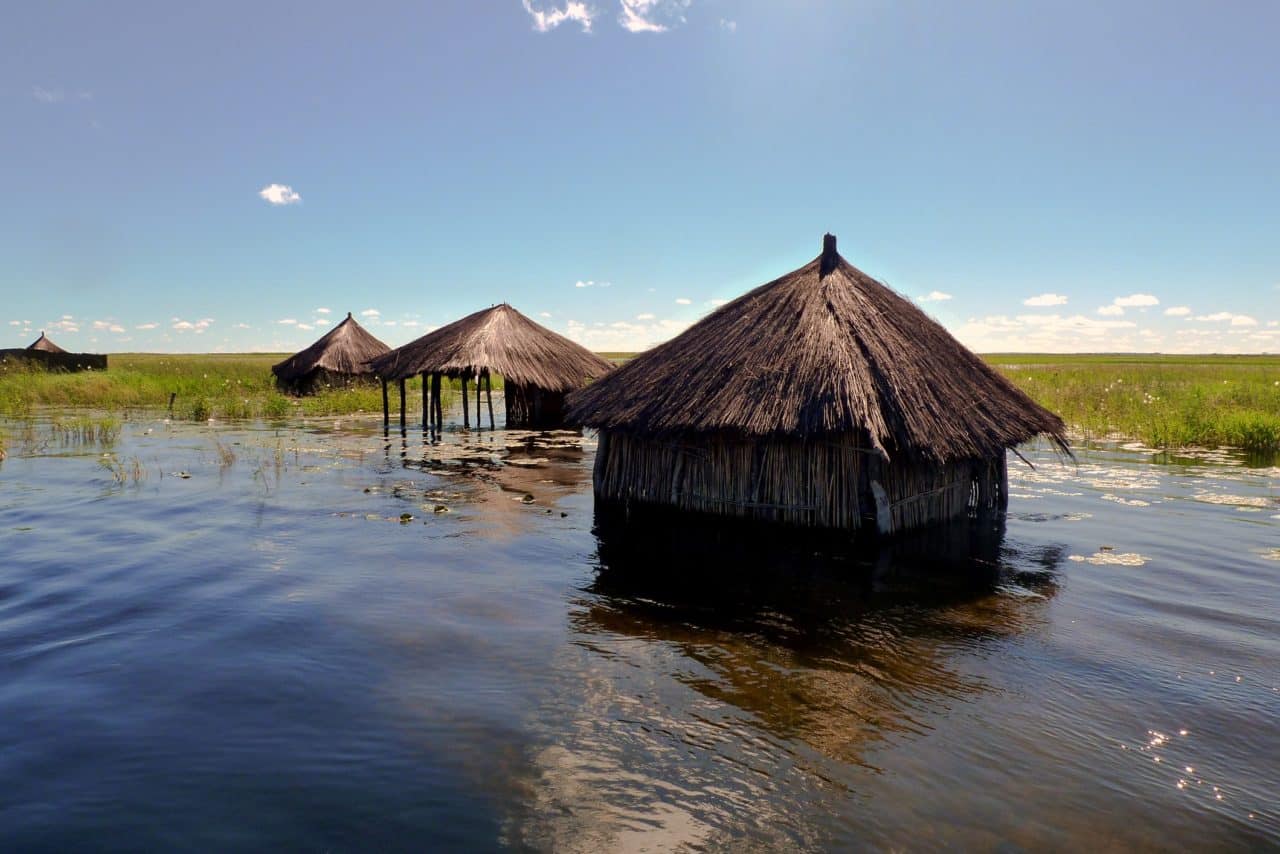
© Gerrit Rautenbach | Dreamstime.com
Using a new macroeconomic model called DYNAMMICs, my colleagues and I have found that there is often a significant growth effect for the economy attached to investing in mitigation measures like dams and drought resistant crops, which is commonly underestimated in traditional models. One reason for this is the focus of other models on only the first, direct dividend. We specifically looked into the examples of Tanzania and Zambia, which show that governments and other stakeholders in developing countries can spur economic growth by investing in DRR measures, thus increasing future earnings and creating a safe environment for investments into other economic activities.
In Tanzania and Zambia, floods affect tens of thousands of people each year (on average 45,000 or .08% of the population in Tanzania and 20,000 or .11% of the population in Zambia). Droughts have more widespread consequences and already affect 11.8% of the population in Tanzania and 19% of Zambians who often lose all or parts of their harvest. This poses an imminent threat to food security in countries where substantial shares of the population rely on subsistence farming as their primary source of income. Given the effects of climate change, these numbers and their ramifications are bound to become ever more pressing issues. However, policymakers, institutions, enterprises, and individuals tend to underinvest in adaption measures.
A promising avenue for demonstrating the potential of DRR investments is offered by including all economic growth effects they invoke into policy analysis, thus showing that besides risk reduction and post-disaster mitigation of destruction, investing in DRR measures can help countries achieve many of their other development goals as well.
We tend to only think of the first dividend of DRR investments, the direct effects of which stop people from being immediately affected by disasters. In the case of Tanzania and Zambia, we examined, among others, the benefits of constructing additional dams. The direct benefits of dams lie in the safeguarding of livelihoods, infrastructure, housing, and agricultural production. These are seen as the first dividend, called the ex-post damage mitigation effect. There are however also additional co-benefits.
In both Tanzania and Zambia, large shares of the population are heavily dependent on agriculture, which makes the introduction of drought-resistant crop varieties such an additional benefit. These crop varieties do not only help farmers preserve their yields in times of disastrous droughts, but additionally support farmers by generating higher yields, even in the absence of disaster. This effect is boosted by the lowered risk for the loss of crops, which spurs investment into farming activities and inputs. Farmers who do not fear losing their entire harvest can, and generally will, invest more into the production of this crop – an example of the second type of dividend, the ex-ante risk reduction effect. This type of economically beneficial effect materializes regardless of the onset of disaster.
The same is true for the third type of dividend, the co-benefit production expansion effect, which is especially relevant for the advantages of dams. The power generation capability of dams, leads to much larger economic gains than the two other dividends combined. In countries such as those at hand with frequent power cuts and comparably low levels of electrification, especially in rural areas, the additional electricity generated can lead to particularly pronounced positive effects by supplying economic actors with access to power. In other scenarios, the provision of ecosystem services is also an important effect falling into this category.
The results we obtained using the DYNAMMICs model are promising: Constructing only two additional dams leads to a 0.3% increase of GDP growth in Tanzania for the next 30 years (0.2% in Zambia) with results largely (97%) driven by the co-benefit production expansion effect. Similarly, the introduction of drought resistant crops and exposure management (i.e., land use restrictions) significantly boost economic growth perspectives. Finally, introducing insurance is a driver for a reduction in the variance of GDP growth, which helps to reduce uncertainty for everyone in the economy. Modeling in such a fashion is therefore an important means of weighing policy options for DRR against each other and for determining optimal levels of investment.
Note: This article gives the views of the author, and not the position of the Nexus blog, nor of the International Institute for Applied Systems Analysis.
Feb 18, 2021 | Austria, Climate, Climate Change, Communication, Education, Health
By Thomas Schinko, Acting Research Group Leader, Equity and Justice Research Group
Thomas Schinko introduces an innovative and transdisciplinary peer-to-peer training program.
What do we want – climate justice! When do we want it – now! The recent emergence of youth-led, social climate movements like #FridaysForFuture (#FFF), the Sunrise Movement, and Extinction Rebellion has reemphasized that at the heart of many – if not all – grand global challenges of our time, lie aspects of social and environmental justice. With a novel peer-to-peer education format, embedded in a transdisciplinary research project, the Austrian climate change research community responds to the call that unites these otherwise diverse movements: “Listen to the Science!”
The climate crisis raises several issues of justice, which include (but are not limited to) the following dimensions: First, intragenerational climate justice addresses the fair distribution of costs and benefits associated with climate change mitigation and adaptation, as well as the rectification of damage caused by residual climate change impacts between present generations. Second, intergenerational justice focuses on the distribution of benefits and costs from climate change between present and future generations. Third, procedural justice asks for fair processes, namely that institutions allow all interested and affected actors to advance their claims while co-creating a low-carbon future. Movements like #FFF maneuver at the intersection of those three forms of climate justice when calling on policy- and decision makers to urgently take climate action, since “there is no planet B”.
Along with the emergence of these youth-led social climate movements came an increasing demand for the expertise of scientists working in the fields of climate change and sustainability research. To support #FFF’s claims with the best available scientific evidence, a group of German, Austrian, and Swiss scientists came together in early 2019 as Scientists for Future. Since then, requests from students, teachers, and policy and decision makers for researchers to engage with the younger generation have soared, also in Austria. Individual researchers like me have not been able to respond to all these requests at the extent we would have liked to.
In this situation of high demand for scientific support, the Climate Change Center Austria (CCCA) and The Federal Ministry of Education, Science and Research (BMBWF) have put their heads together and established a transdisciplinary research project – makingAchange. By engaging early on with our potential end users – Austrian school students – a truly transdisciplinary team of researchers as well as practitioners in youth participation and education (the association “Welt der Kinder”) has co-developed this novel peer-to-peer curriculum. The training program, which runs over a full school year, sets out to provide the students not only with solid scientific facts but also with soft skills that are needed for passing on this knowledge and for building up their own climate initiatives in their schools and municipalities. One of the key aims is to provide solid scientific support while not overburdening the younger generation who often tend to put too high demands on themselves.
Establishing scientific facts about climate change and offering scientific projections of future change on its own does not drive political and societal change. Truly inter- and transdisciplinary research is needed to support the complex transformation towards a sustainable society and the integration of novel, bottom-up civil society initiatives with top-down policy- and decision making. Engaging multiple actors with their alternative problem frames and aspirations for sustainable futures is now recognized as essential for effective governance processes, and ultimately for robust policy implementation.
Also, in the context of makingAchange it is not sufficient to communicate science to students in order to generate real-world impact in terms of leading our societies onto low-carbon development pathways. What is additionally needed, is to provide them with complementary personal and social skills for enhancing their perceived self-efficacy and response efficacy, which is crucial for eventually translating their knowledge into real climate action in their respective spheres of influence.
Recent insights from a medical health assessment of the COVID-19 related lockdowns on childhood mental health in the UK have shown that we are engaging in an already highly fragile environment. In addition, a recent representative study for Austria has shown that the pandemic is becoming a psychological burden. The study authors are particularly concerned about young people; more than half of young Austrians are already showing symptoms of depression. Hence, we must engage very carefully with the makingAchange students when discussing the drivers and potential impacts of the climate crises. Particularly since some of them are quite well informed about research, which has shown (by using a statistical approach) that our chances of achieving the 1.5 to 2°C target stipulated in the Paris Agreement are now probably lower than 5%. Another example of such alarming research insights comes in the form of a 2020 report by the World Meteorological Organization, which warns that there is a 24% chance that global average temperatures could already surpass the 1.5°C mark in the next five years.
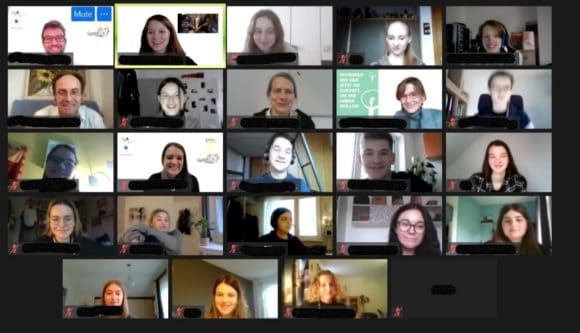
Zoom group picture taken at the end of the second online makingAchange workshop for Austrian school students. Copyright: makingAchange
The first makingAchange activities and workshops have now taken place – due to the COVID-19 regulations in an online format, which added further complexity to this transdisciplinary research project. Nevertheless, we were able to discuss some of the hot topics that the young people were curious about, such as the natural science foundations of the climate crisis, climate justice, or a healthy and sustainable diet. At the same time, we provided our students with skills to further transmit this knowledge and to take climate action in their everyday live – such as a climate friendly Christmas celebration in 2020. The school student’s lively engagement in these sessions as well as the overall positive (anonymous) feedback has proven that we are on the right track.
The role of science is changing fast from “advisor” to “partner” in civil society, policymaking, and decision making. By doing so, scientists can play an important, active role in implementing the desperately needed social-ecological transformation of our society without becoming policy prescriptive. With the makingAchange project, we are actively engaging in this transformational process – currently only in Austria but with high ambitions to scale-out this novel peer-to-peer format to other geographical and cultural contexts.
Note: This article gives the views of the author, and not the position of the Nexus blog, nor of the International Institute for Applied Systems Analysis.
Dec 17, 2020 | Climate Change, COVID19, Sustainable Development
By Greg Davies-Jones, 2020 IIASA Science Communication Fellow
Greg Davies-Jones finds out how COVID-19 has lightened the carbon footprint of IIASA and uncovers how the institute plans to integrate climate protection and sustainability into everyday research activities.
The impact of COVID-19 has been profound and pervasive, infiltrating deeply into many spheres of society. IIASA has not escaped the clutches of the pandemic either: The phrase ‘unprecedented times’ has become just as commonplace here at the institute as it has across the globe. Despite the overt and all too evident adverse consequences of COVID-19, there is a significant, albeit only temporary, positive aspect of a lockdown existence, namely a reduction in carbon dioxide (CO2) emissions.
At IIASA, the principal decline in CO2 emissions has been due to the drop-off in business travel. With individual mobility heavily restricted, travel arising out of research activities, meetings, and conferences has dropped to almost zero. To fill the void, the virtual world is rapidly becoming the everyday reality: Zoom calls, Skype meetings, audio hiccups, video glitches, and the occasional gallivanting toddler have fast become the norm in this new working world.

Schloss Laxenburg | ©IIASA
In the years to come, when the COVID-19 cobwebs are finally blown away (hopefully), might this new working world become more commonplace? A hybrid between the pre-COVID-19 and post COVID-19 worlds perhaps? One thing is certain: The continuation of business-as-usual will be catastrophic environmentally. A recent climate poll documented in The Guardian found despairingly that people are planning to drive and, in some cases, even fly more in the future than before the coronavirus pandemic. The dangerous inference that could be drawn from this is that, rather than merely a disconnect between individual actions and outcomes, there are conscious choices being made that are increasingly recognized as being highly inimical to the continued existence of most life forms on this planet.
Given the global shock to the economy, cost will also be a key factor influencing decisions in the post COVID-19 world. Virtual conferencing is pre-eminently a cheaper alternative. Although not a perfect substitute for in-person meetings – it does come with advantages (e.g., lower resource requirements and better accessibility) as well as disadvantages (e.g., lacking informal exchanges).
“Another aspect is inclusivity ̶ virtual conferencing affords people the opportunity to engage with relative ease (provided they have a sound internet connection), irrespective of their geographical location,” explains IIASA researcher Caroline Zimm.
Fellow researcher, Benigna Boza-Kiss, continues: “The virtual working world can be fruitful and effective, but we must be more strategic in how it is organized. Structured meetings with specific objectives planned in advance will allow for ineffectual activity and call-times, which similarly generate emissions, to be reduced.”
Notwithstanding these positives of a virtual working environment, there are some apprehensions, particularly regarding the impossibility of virtual platforms to meaningfully replicate certain types of social interactions, including those that occur outside structured sessions at conferences. Conversations beside the coffee machine, chinwags in the corridor, or even the post-work evening revelry – all such serendipitous moments and gainful interaction are considered invaluable in providing the ‘complete’ conference experience. Yet, the virtual world can offer other distinct advantages.
“In video calls and online conferencing platforms, it is not as daunting to ‘raise a hand’ or contact someone more senior. I have found that some people actually speak up more (often using the chat function) than they would in a physical conference setting. This means a shift in the networking dynamic and perhaps even greater inclusivity,” says Zimm.
The lightening of the carbon footprint of IIASA research ventures will likely be short-lived unless we make fundamental changes over the long-term. As the time window in which we can effectively act on climate change inexorably closes, it is imperative that we do more to attain the universal climate goals written into the Paris Agreement.
In light of this challenge, and considering the work of IIASA as a leader in environmental and sustainability studies, it feels appropriate to ask: Should the prevailing ethos of environmental institutes and practitioners therein openly acknowledge and embrace the responsibility to act as role models in reducing negative environmental impact? Put bluntly, should it be incumbent upon them to ‘walk the talk’? Are people more likely to respond to organizations and researchers that practice what they preach?
Many environmental institutes and researchers, at least nominally, would agree, but this purported espousal must be underpinned by concrete action. In 2019, IIASA joined forces with Climate Alliance Austria – an organization focusing on awareness-raising projects and activities to promote knowledge on climate issues and sustainable development. The IIASA-Climate Alliance mandate is to integrate climate protection and sustainability into everyday research.
To advance this philosophy, IIASA has formed an internal Environment Committee that focuses on nurturing more environmentally friendly processes and activities at the institute. To this end, the committee has organized an evaluation and is elaborating a strategy that includes developing Green Event Guidelines, powering IIASA with certified green electricity, and encouraging individual action with a ‘Bike to Work’ scheme.
For the most part however, these are all fledgling initiatives that require cultivation, top level support and leadership to ensure success. Moreover, these initiatives necessitate additional targeted and hard-hitting emission-mitigation strategies to avoid frustratingly commonplace ‘greenwashing’ and ensure decisive, positive internal climate action. More stringent measures, such as the institute’s proposed stricter sustainable procurement and travel policies, will arguably make a powerful and lasting contribution to this over-arching aim of “reconfiguring” IIASA as an employer that is doing all it can to implement and facilitate sustainable working practices for its entire workforce.
Note: This article gives the views of the author, and not the position of the Nexus blog, nor of the International Institute for Applied Systems Analysis.
Dec 7, 2020 | Biodiversity, Climate Change, Food & Water, Women in Science, Young Scientists
By Shorouk Elkobros, 2020 IIASA Science Communication Fellow
Being mindful of biodiversity loss and environmental impact can disrupt the beef industry globally, here’s how.
In his new polemical Netflix documentary, A life on our planet, Sir David Attenborough argues that, “We live on a finely tuned life support machine, one that relies on its biodiversity to run smoothly.”
The decline in biodiversity challenges the world’s capacity to produce food for a growing population. That is ironic when global food production itself is a contributing factor to biodiversity loss, especially beef production.
What’s wrong with the beef industry?
Here are a couple of the current challenges facing the beef industry: Cows are major culprits in climate change because they emit methane, a potent greenhouse gas. Beef production is the number one driver of deforestation and habitat loss in tropical forests. Grazing cattle also require a large amount of grass that requires using harsh nitrogen fertilizers. Hence, the beef production industry contributes heavily to biodiversity loss, which has dire consequences for the planet.
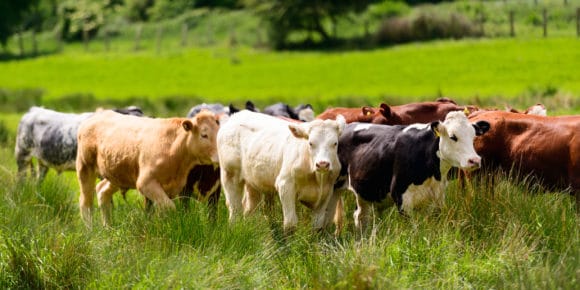
©Jonathan Casey | Dreamstime.com
There is no silver bullet to solve the challenges beef production poses to the environment. Research is going above and beyond to find diverse and integrated solutions that can go hand in hand to combat this challenge. Whether through ways to reduce methane emissions, such as creating an anti-burp vaccine for cows, designing lab-grown meat, or shifting diets to plant-based alternatives.
Katie Lee, an alumna of the 2020 IIASA Young Scientists Summer Program (YSSP) and PhD student at the University of Queensland in Brisbane, Australia, is part of a broader project that focuses on redistributing where we produce beef to minimize its impact on greenhouse gas emissions and biodiversity, as well as on the cost of production.
“I am particularly interested in ways to enhance the types of beef production systems. With the challenges of its water use, greenhouse gas emissions, and the large areas of land it requires compared to any other food source, any small changes we propose can have a big impact,” she explains.
For Lee, solutions to global food security are crucial, and looking at the status of production systems is both a need and a must. The world population is expected to reach 9.7 billion people by 2050. So, when thinking about ways to feed 10 Billion people by 2050, it becomes clear that it is not enough to simply look at beef alternatives without enhancing its current demand and supply chains. Lee thinks it is more efficient to pragmatically alter and improve the environmental impact of beef production than to convince people to stop eating beef.
It is understood that reducing beef consumption has health benefits. However, with a growing interest in alternative meat options, the question remains of which markets this appeals to, and how environmentally friendly and energy- and water intensive these alternatives are.
“While demand reduction on meat is important, sometimes it is not feasible in countries that do not have economic security or are still growing in terms of affluence, which leads to an increase in beef consumption. That is why we need to look at the producer side and the consumer side, as well as everything in between to have the biggest impact. I was particularly interested to conduct this research in cooperation with IIASA, mainly because the institute has a good history of looking at the impact of beef, particularly in terms of greenhouse gas emissions,” says Lee.
A win-win all-round solution
Using the IIASA Global Biosphere Management Model (GLOBIOM), Lee is assessing the impact on greenhouse gas emissions and biodiversity when shifting both the production and demand of beef. Preliminary results from her ongoing study show a reduction in impact on biodiversity and greenhouse gas emissions, as well as a reduction of the producer price when switching away from extensive grazing systems ̶ a win-win situation all-round.
“Few studies explicitly address biodiversity loss compared to investigating ways to reduce greenhouse gas emissions. I want to show stakeholders that beef production can be more efficient in terms of reducing its impact on greenhouse gas emissions and biodiversity. I am hopeful that this study can help beef producers to be mindful of this when making choices. That will be a win for the environment if it goes together with a proactive reduction of meat consumption,” concludes Lee.
Similar to Lee’s study and using a set of large-scale economic models including GLOBIOM, the IIASA AnimalChange research project aims to assess the global scale adaptation and mitigation options of the livestock sector to ensure a sustainable livestock production sector by 2050.
Limiting global warming and protecting biodiversity should be a priority when designing food systems able to feed an increasing population. As a food producer, whether you raise cattle or design cell cultured meat, it is important to be conscious about livestock hoof prints on biodiversity. As a food consumer, it is necessary to be mindful of having a healthy and sustainable diet that does not put the planet in jeopardy. Sustainable beef production might not be the panacea to future biodiversity loss or food scarcity, yet it can offer a significant change.
Note: This article gives the views of the author, and not the position of the Nexus blog, nor of the International Institute for Applied Systems Analysis.
Nov 20, 2020 | Climate Change, Risk and resilience, Young Scientists
By Greg Davies-Jones, 2020 IIASA Science Communication Fellow
Greg Davies-Jones sits down with 2020 IIASA Young Scientists Summer Program (YSSP) participant Lisa Thalheimer to discuss how attribution science can play a leading role in addressing disaster displacement.
We live in the era of the greatest human movement in recorded history – there are more people on the move today than at any other point in our past. Despite the common misconception that most migrants cross borders, a lot of migration actually occurs internally. According to the Internal Displacement Monitoring Center, a staggering 72% of internal migration is linked to displacement due to natural hazards or extreme weather.
Pinpointing the finer details of how human mobility might evolve remains a complex undertaking. Contemporary migratory movements reflect the complex patterns of social and economic globalization – they flow in all directions and affect all countries in one way or another. It is clear that given the rising global average temperatures, natural hazards and extreme weather events will increase in frequency, intensity, and duration, adversely effecting many parts of the globe. A better understanding of how human-induced climate change influences disaster displacement will undoubtedly be essential in addressing future human mobility and informing the debate on climate and migration policies.
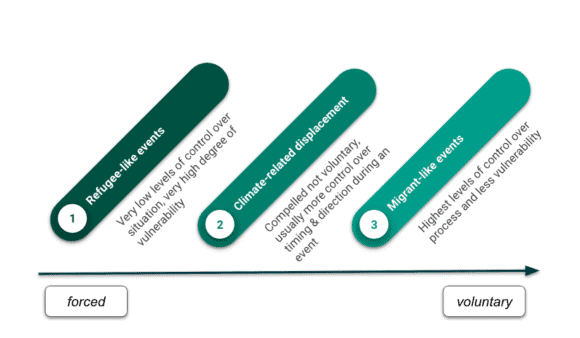
Figure: Climate-related displacement on an axis of forced to voluntary human mobility. Thalheimer (2020)
The focus of 2020 YSSP participant Lisa Thalheimer’s research is on internal displacement in East Africa, in particular, Somalia. As part of her YSSP project, Thalheimer hopes to determine whether, and to what extent, human-induced climate change altered the likelihood of extreme weather-related displacement in Somalia by conflating econometric methods and Probabilistic Event Attribution (PEA).
“Econometrics is essentially the application of statistical methods to quantify impacts and PEA is a way of examining to what extent extreme weather events can be linked with past man-made emissions. By combining the two methods we hope to quantify the ramifications of extreme weather and displacement in East Africa,” she explains.
This is no mean feat, as PEA itself is a relatively new science and many challenges still exist in the field of event attribution ̶ a field of research concerned with the process by which the causes of behavior and events can be explained. In this instance, the idea was to study each extreme weather event individually to determine if human-induced climate change may have added to the intensity or likelihood of the event occurring. PEA is a growing science within this field and relies on the availability of long-term meteorological observations and the reliability of climate model simulations. In terms of migration and the accompanying econometric methods, the complexity of this work is mainly in data capturing.
“The difficulty with migration data capturing is at the start – before you can capture anything, you must ascertain how the data is defined, as different countries define mobility in different ways. For instance, it could be time – where did you live one year ago as opposed to five years ago? That’s the first complexity. Then you must work out who collects data on who – in Europe, we have fundamental freedom of movement within the EU, so unless you file for residency, your movement is not recorded. Another complexity is because we want to see if climate change is part of the driver ̶ directly or indirectly. We need to know not just where people are now, but where they have been and where they came from, so we can match the climate with their movements. All of this highlights how difficult it is to carry out this type of analysis,” Thalheimer adds.
In Somalia, the team relied on previously collected forced migration data, for example, from the UN High Commissioner for Refugees (UNHCR). These UNHCR datasets collected in Somalia were comprehensive and included not only origin and destination information but also a categorization of the primary reason for the displacement.
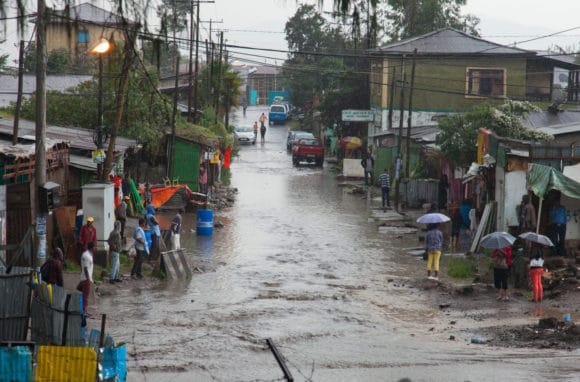
© Aleksandr Frolov | Dreamstime.com
The investigation homed in on one extreme weather case study in the region: The April 2020 heavy rainfall in Southern Ethiopia, which led to several severe flooding events in South Somalia. In this particular case, however, no appreciable connection could be made between human-induced climate change and the resultant displacement. Despite this somewhat chastening outcome, the achievement of this study is not proving a definitive attributable link between human-induced climate change and the April 2020 rainfall, but rather the construction of the adjustable attribution framework presented that can be applied directly to other events and displacement contexts.
As previously mentioned, there are, however, limitations to this novel methodology, especially in regions like Somalia that lack exhaustive observational weather and displacement data. According to Thalheimer, exploring ways of effectively applying this framework in countries vulnerable to climate change will be particularly important going forward.
“Event attribution studies do not usually form the basis of climate migration analysis, disaster risk reduction, or adaptation strategies. Yet, to respond appropriately to these impacts and affected populations, we must develop a comprehensive and detailed understanding of the nature of these impacts, as well as knowledge on how these might evolve over time. Event attribution is a tool we can employ to do this,” she concludes.
Note: This article gives the views of the author, and not the position of the Nexus blog, nor of the International Institute for Applied Systems Analysis.
Nov 10, 2020 | Air Pollution, China, Climate Change, Energy & Climate, Young Scientists
By Xu Wang, IIASA Young Scientists Summer Program (YSSP) alumnus and Assistant Professor at Beijing University of Technology and Pallav Purohit, researcher in the IIASA Air Quality and Greenhouse Gases Program.
Xu Wang and Pallav Purohit write about their recent study in which they found that accelerating the transition to climate-friendly and energy-efficient air conditioning in the Chinese residential building sector could expedite building a low-carbon society in China.

© Shao-chun Wang | Dreamstime.com
China saw the fastest growth worldwide in energy demand for space cooling in buildings over the last two decades, increasing at 13% per year since 2000 and reaching nearly 400 terawatt-hours (TWh) of electricity consumption in 2017. This growth was largely driven by increasing income and growing demand for thermal comfort. As a result, space cooling accounted for more than 10% of total electricity growth in China since 2010 and around 16% of peak electricity load in 2017. That share can reach as much as 50% of peak electricity demand on extremely hot days, as seen in recent summers. Cooling-related carbon dioxide (CO2) emissions from electricity consumption consequently increased fivefold between 2000 and 2017, given the strong reliance on coal-fired power generation in China [1].
In our recent publication in the journal Environmental Science and Technology, we used a bottom-up modeling approach to predict the penetration rate of room air conditioners in the residential building sector of China at the provincial level, taking urban-rural heterogeneity into account. Our results reveal that increasing income, growing demand for thermal comfort, and warmer climatic conditions, could drive an increase in the stock of room air conditioners in China from 568 million units in 2015 to 997 million units in 2030, and 1.1 billion units in 2050. In urban China, room air conditioner ownership per 100 households is expected to increase from 114 units in 2015 to 219 units in 2030, and 225 units in 2050, with slow growth after 2040 due to the saturation of room air conditioners in the country’s urban households. Ownership of room air conditioners per 100 households in rural China could increase from 48 units in 2015 to 147 units in 2030 and 208 units in 2050 [2].
The Kigali Amendment to the Montreal Protocol on Substances that Deplete the Ozone Layer will help protect the climate by phasing down high global warming potential (GWP) hydrofluorocarbons (HFCs), which are commonly used as refrigerants in cooling technologies [3]. Promoting energy efficiency of cooling technologies together with HFC phase-down under the amendment can significantly increase those climate co-benefits. It is in this context that we assessed the co-benefits associated with enhanced energy efficiency improvement of room air conditioners (e.g., using efficient compressors, heat exchangers, valves, etc.) and the adoption of low-GWP refrigerants in air conditioning systems. The annual electricity saving from switching to more efficient room air conditioners using low-GWP refrigerants is estimated at almost 1000 TWh in 2050 when taking account of the full technical energy efficiency potential. This is equivalent to approximately 4% of the expected total energy consumption in the Chinese building sector in 2050, or the avoidance of 284 new coal-fired power plants of 500 MW each.
Our results indicate that the cumulative greenhouse gas mitigation associated with both the electricity savings and the substitution of high-GWP refrigerants makes up 2.6% of total business-as-usual CO2 equivalent emissions in China over the period 2020 to 2050. Therefore, the transition towards the uptake of low-GWP refrigerants is as vital as the energy efficiency improvement of new room air conditioners, which can help and accelerate the ultimate objective of building a low-carbon society in China. The findings further show that reduced electricity consumption could mean lower air pollution emissions in the power sector, estimated at about 8.8% for sulfur dioxide (SO2), 9.4% for nitrogen oxides (NOx), and 9% for fine particulate matter (PM2.5) emissions by 2050 compared with a pre-Kigali baseline.
China can deliver significant energy savings and associated reductions in greenhouse gas and air pollution emissions in the building sector by developing and implementing a comprehensive national policy framework, including legislation and regulation, information programs, and incentives for industry. Energy efficiency and refrigerant standards for room air conditioning systems should be an integral part of such a framework. Training and awareness raising can also ensure proper installation, operation, and maintenance of air conditioning equipment and systems, and mandatory good practice with leakage control of the refrigerant during the use and end-of-life recovery. Improved data collection, research, and cooperation with manufacturers can equally help to identify emerging trends, technology needs, and energy efficiency opportunities that enable sustainable cooling.
References:
[1] IEA (2019). The Future of Cooling in China: Delivering on Action Plans for Sustainable Air Conditioning, International Energy agency (IEA), Paris.
[2] Wang X, Purohit P, Höglund Isaksson L, Zhang S, Fang H (2020). Co-benefits of energy-efficient air conditioners in the residential building sector of China, Environmental Science & Technology, 54 (20): 13217–13227 [pure.iiasa.ac.at/16823]
[3] Purohit P, Höglund-Isaksson L, Dulac J, Shah N, Wei M, Rafaj P, Schöpp W (2020). Electricity savings and greenhouse gas emission reductions from global phase-down of hydrofluorocarbons, Atmospheric Chemistry and Physics, 20 (19): 11305-11327 [pure.iiasa.ac.at/16768]
Note: This article gives the views of the author, and not the position of the Nexus blog, nor of the International Institute for Applied Systems Analysis (IIASA).








You must be logged in to post a comment.